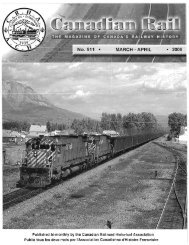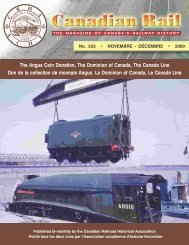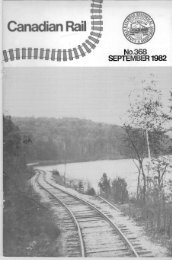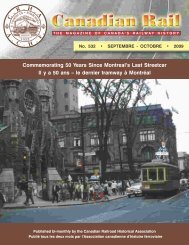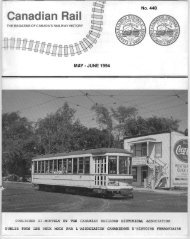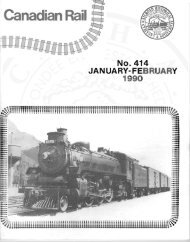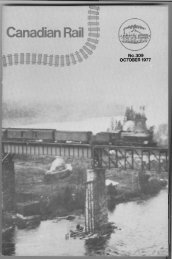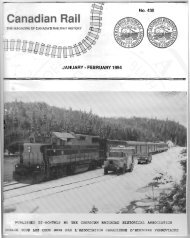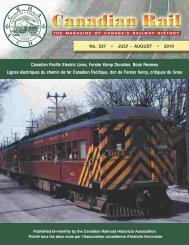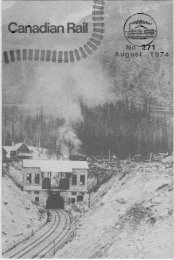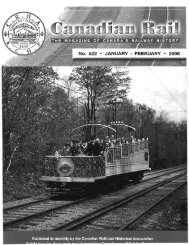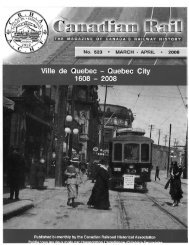Canadian Rail_no536_2010 - Le musée ferroviaire canadien
Canadian Rail_no536_2010 - Le musée ferroviaire canadien
Canadian Rail_no536_2010 - Le musée ferroviaire canadien
You also want an ePaper? Increase the reach of your titles
YUMPU automatically turns print PDFs into web optimized ePapers that Google loves.
RAIL CANADIEN • 536 134<br />
MAI – JUIN <strong>2010</strong><br />
known in <strong>Canadian</strong> history as the "national dream" - a<br />
transcontinental railway to unify the sparsely populated<br />
country. Canada that had been born in 1867 as a result of<br />
the British North America Act. But to get British<br />
Columbia to join Confederation as the sixth province in<br />
1871, an amendment to the BNA Act entrenched a<br />
federal promise to BC to create a transcontinental rail<br />
link.<br />
Construction of that link was completed as a<br />
result of an 1881 contract between the federal<br />
government and the seven members of the new <strong>Canadian</strong><br />
Pacific <strong>Rail</strong>way syndicate. Then, as now, parties to<br />
contracts were entitled to their own original copies. As<br />
one of seven original investment partners in the CPR<br />
syndicate and one of four original company directors,<br />
R.B. Angus received his own handsome leather-bound<br />
copy.<br />
This copy - the same one that Fred Angus told<br />
Exporail president Stephen Cheasley about - is the only<br />
original copy known to exist today. This copy was part of<br />
the museum's temporary exposition titled “What’s In The<br />
Box?”. The exposition, which ran at Exporail until April<br />
11, featured the best of <strong>Canadian</strong> railway memorabilia<br />
donated or bequeathed to the museum during the last<br />
five years. The title refers to the many precious items that<br />
were mailed / delivered / or picked up by the museum in<br />
little boxes. (Montreal Gazette)<br />
Study of Chelsea, Quebec steam train station<br />
contracted<br />
A group of consultants has been hired to do a<br />
feasibility study on a Chelsea station for the Hull-<br />
Chelsea-Wakefield steam train. The federal government<br />
will pay $206,550 of the study's $275,400 cost. The study<br />
will examine the impact of a proposed train station on the<br />
environment, local economy, drainage, water and sewer<br />
services and transportation.<br />
Surveys and other field work started during the<br />
last week of November. Tim Kehoe, study director, said<br />
the station could provide Chelsea with some economic<br />
benefit if passengers visit Old Chelsea shops and<br />
restaurants. Innovation Chelsea, a business group, has<br />
proposed locating a steam train station on a 50-acre site it<br />
owns that includes a medical clinic.<br />
Community Table Outaouais, a group that helps<br />
develop economic opportunities for West Quebec<br />
residents, is participating. Other groups contributing to<br />
the study include Caisse Desjardins de Hull, Centre local<br />
de développement des Collines-de-l'Outaouais, Hull-<br />
Chelsea-Wakefield Steam Train and Tourisme Outaouais.<br />
Chelsea Mayor Caryl Green said the former passenger<br />
rail station north of Old Chelsea played an important role<br />
in the community until it closed during the 1960s. (Ottawa<br />
Citizen)<br />
Glorious railway relic sits on track to nowhere in<br />
Ajax<br />
A railway spur line that slows down traffic in Ajax<br />
may be in a state of disrepair, but not the marvellous<br />
passenger train car that resides at the end of it. The spur<br />
that crosses Dowty Road, near Highway 401 and Westney<br />
Road exists to permit the switching of an opulent<br />
passenger car, the Pacific, to and from the CN.<br />
The Pacific was built by the <strong>Canadian</strong> Car &<br />
Foundry Company for the CNR in 1924 with six<br />
compartments, a buffet, lounge and observation<br />
platform. The car was originally built for charter service<br />
to private parties. It was part of the royal train operated<br />
for King George VI in 1939 and the whistle-stop



